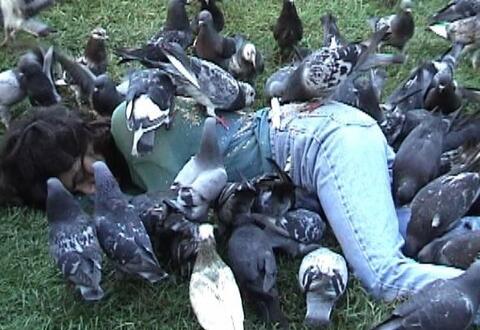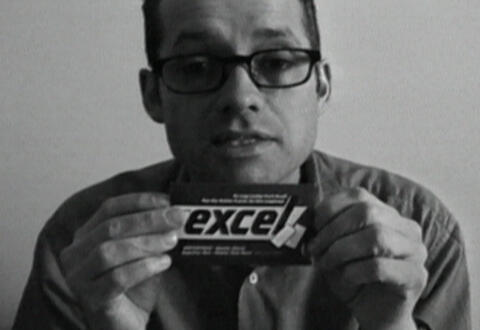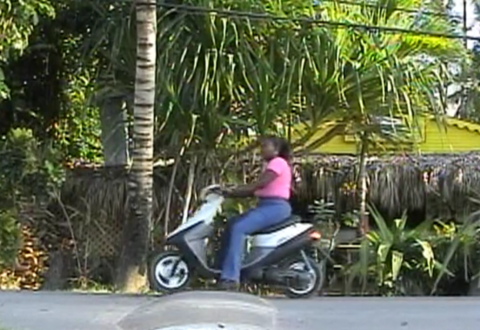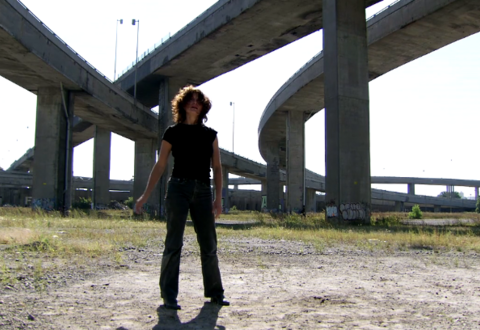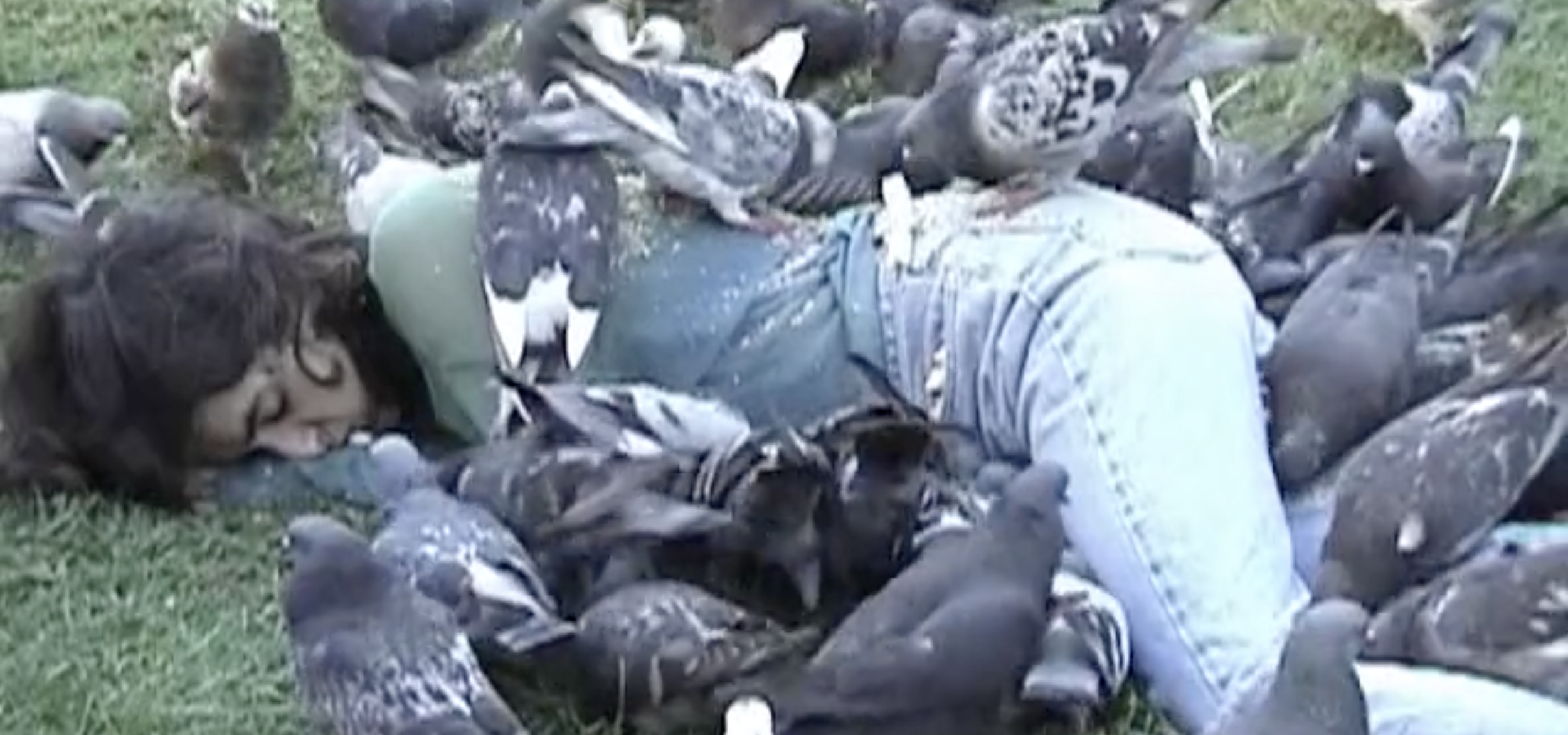
Carte blanche to Sophie présente : Me at the zoo
Sophie presents Me at the zoo, a program that portrays a gluttonous system through six art videos made between 1990 and 2010. Taking as a point of departure the idea that the video clips that proliferate on the internet are a fast-growing product of consumerism mirroring by the uncontrolled flow of capital, the curator is interested in the aesthetic of the ephemeral content that is generated by users every day. The program follows an exponential and metaphorical trajectory, with the medium becoming increasingly abstract, as if the videos consume themselves.
Sophie Latouche is an independent curator and artist based in Tiohtiá:ke/Mooniyang/Montreal. She co-founded the online net.art platform Galerie Galerie, worked as associate director at gallery Pangée, and organizes various exhibitions as an independent curator at Sophie présente. She holds a Master's in Cultural Organization Management from HEC Montréal and a BFA in Intermedia/Cyberarts from Concordia University. Her artistic work has been shown at institutions including MAC Montréal, MAC LAU, Centre Clark, Le Lobe, and the Cinémathèque Québécoise.
List of works in program
As I research this program, the news speaks to me about Donald Trump and his administration being influenced by the Dark enlightenment[1], a movement that calls for the uncontrolled flow of capitalism and the destruction of everything in its path. As fascism spreads across the world, I watch 80 minutes of short videos per day[2] -- I see trompe l’œil desserts, New York exhibitions, Italian cats, and the Coachella music festival, asking me what the song of the summer of 2025 will be. I’m hoping it will be Bella Ciao![3]
Taking as a point of departure the idea that the video clips that proliferate on the internet are a fast-growing product of consumerism reflects the uncontrolled flow of capital, I look at the aesthetic of the ephemeral content that users generate every day. In order to put the present moment into context, I focussed on videos made prior to 2010 – before the introduction of the ‘stories’ format in 2013[4], before post-internet art went “mainstream” in 2014[5], and before the new Turcot interchange in 2020. Artists have always been at the forefront, questioning, reflecting upon, and experimenting with media content and its technical and ideological limitations. I was curious to see what my ‘brain rot’ eyes would find.
Moi au zoo depicts a gluttonous system through six art videos made between 1990 and 2010. The program follows an exponential and metaphorical trajectory, with the medium becoming increasingly abstract, as if the videos begin to consume themselves. A flock of pigeons, a GRWM with a pack of gum, a trip to the south, dance, illness, tragedy, and erasure; the videos follow one after the other in a sort of algorithmic narrative.
While exploring the works in the collection at Vidéographe, I thought about the way in which access to video recording devices has allowed artists to leave the gallery to document their performances and interrogate time, space and the body. In Rachel Echenberg’s work Blanket: Pigeons, the artist exposes the vulnerability of those who have been swallowed up by the system. A woman lies motionless on the grass in the park, covered in pigeons that move and crawl over her. The close-ups of the city birds, the jeans worn by the performer, and the ambient sounds are all familiar to me: we’re in Montréal – it’s nothing out of the ordinary. I feel as though I’ve come across a moment recorded by someone in my network: an everyday scene gone wrong. The inertia performed here gives the impression of a person who has given up. If we die, will the cities’ pigeons devour us, one small bite at a time? We disseminate our own narratives on the web in real time; we transform our daily lives into images and we nibble those of other people.
The video that’s recognized as the first to be posted on YouTube, in 2005, was called ‘Me at the zoo’[6]. The 19-second-long video shows one of the platform’s cofounders, before it was bought by Google, speaking directly to the camera and standing in front of two elephants at the San Diego Zoo. He gives a brief description of his experience (‘it’s cool’), a precursor to the content generated by users. However, in 1999, in his 52-second video E for Excel, Nelson Henricks had already explored similar codes. In a format that is extremely familiar today, the artist addressed the camera directly to say, ‘When I want a gum, not any gum…’. While a video is not always monetized in itself, its effect on us is. Whether the stories come from a business, an influencer or a friend, they coexist on the web without much distinction, employing similar mechanisms. Henricks speaks quickly, in a detached manner, as if there’s no time to spare: “I think I’m up to about one, two packs a day now. At a dollar a package, this is a lot of money to be spending on gum… Excel, c’est excellent!”[7] His tone is post-ironic, it signals an awareness of his powerlessness, his giving in to the systemic forces that dictate his movements. After all, even if things aren’t going well, we can always buy ourselves a little something. Watching this type of content incarnates a sort of palindrome: consume a consumer who consumes. The swallower is swallowed.
In Policia Acostada by Natalie Rich-Fernandez, a speed bump by the beach in the Dominican Republic causes discomfort to drivers, forcing them to adapt their movements. The still camera embodies the tourist’s voyeuristic eye in this idyllic landscape, the slowing of traffic allowing it to capture the continuous flow – of things, people, power relations, social class. “The growing distress that the accumulation of wealth brings about sometimes appears to be part of ‘the order of things’. Like a towel at an all-inclusive, it looks well-folded, in the form of a bird. The system that constructs it articulates it with such grace that it appears inevitable.” [8] With the pace set by the editing, the chaos and frenzy of the traffic evokes the idea of flow.
Recently, a user posted a remake of the famous video at the San Diego Zoo on YouTube.[9] In this homage, he reenacts the author’s exact words and gestures, but 20 years later. The same approach is taken in Dédale (2008) by Mario Côté, in which dancer Ginette Boutin performs a new version of choreography by Françoise Sullivan and Jeanne Renaud, which was performed for the first time in 1948. When I think of Sullivan, I think of her automatist paintings and sculptures, as well as the photographs of her famous Danse dans la neige[10]. The choreography, which rejects classic dance to explore expressive improvised gestures, was performed beyond the walls of a gallery or studio: the artist dances in the snow – a typical Quebec backdrop. In Côté’s video, the dancer is also outside: under the imposing concrete structure of the Turcot interchange. This recontextualization recalls the nascent and profuse ideologies of the Quiet Revolution. Above the sound of the traffic and machinery, I listened to the dancer’s breath as she reproduces the liberating and revolutionary movements of Sullivan’s era. There is something tragic in this repetition: perhaps we have forgotten that we had to fight to liberate the body. ‘We go from inside to out, that’s to say from man’s inner self to the exterior matter, the art object that he confronts. In this case, time, space, gravity, everything has to be redone, our decline having projected us so deeply into chaos.’[11]
A system’s oppressions are not always visible, such as the microparticles that pass through our bodies. In Tout désir d'oubli disparu/All wish for oblivion has vanished (1991) by Johane Fréchette, the author shares her experience with cancer. The video format has moved away from steady shots and light interventions; it is now busy, glitchy, split into three, with archive images and video clips superimposed like a collage. The artist draws a parallel between her story and that of belugas in the Saint Laurent estuary, who also die of cancer, in alarming numbers. Both are victims of an invisible invasion, an infiltration that modifies molecules, like the images that become distorted. On several occasions over the years, the author of the first YouTube video[12] has updated its description, using the video’s popularity to draw attention to different issues. In February 2025, the description referred to studies about the presence of microplastics in the brain. He is also afraid.
Frogfields by Katherine Liberovskaya explores electronically altered imagery with a Sandin video synthesizer (1971), one of the first DIY modular devices, which was invented by Daniel J. Sandin, a pioneer of computer graphics and experimental electronic art. In the video, images of frogs, filmed at the Bronx Zoo in 2009, are distorted by the electric current and signals. The repetitions, loops and colors that emerge reveal the beauty of the medium itself. The frog in captivity has become an image that has now been swallowed up by the format that contains it. The 15-minute video invites a sort of meditation as we’re lulled by the sounds of the signals, the electronic beats: are amphibians in the way of capitalism?
/ \
_(I)(I)_
( _ .. _ )
`.`--'.'
) (
,-./ \,-.
( _( || || )_ )
__\ \\||--||'/ /__
`-._//||\/||\\_.-'
`--'`--'
[1] Philomag, ‘Les penseurs qui murmurent à l’oreille de Trump’, Arnaud Miranda, published in February 2025
[4] Le Monde, ‘Les « stories » : l’histoire d’un format qui s’est imposé sur tous nos réseaux sociaux’,Grégor Brandy, published in 2021
[5] I-D magazine,’2014, the year… the post internet art world went mainstream’, Felix Petty, published December 2014
[7] Nelson Henricks, E for Excel (1999), Canada, 0:52
[8] Daphné B., Maquillée, (Marchand de feuilles, 2020), p.163
[10] Françoise Sullivan, Danse dans la neige, 1948, Performance, photograph by Maurice Perron, MNBAQ, Québec
[11] Françoise Sullivan, ‘La danse et l’espoir’, in Refus global, Paul-Émile Borduas, Saint-Hilaire (Québec), (Myrtha Mythe, 1948)






